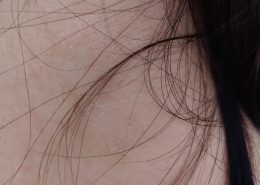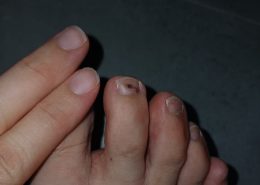I have this dry patch on the back of my neck that itches occasionally, I have tried moisturizer and anti-fungal cream but the patch still doesnt go away but doesnt seem to be spreading as well.. how to tell if ...
Yes, certain skincare ingredients can be absorbed through the skin and potentially enter the bloodstream, where they may affect overall health, including gut health. Here are some key considerations: 1. Parabens: - Parabens are commonly used preservatives in cosmetics and skincare products. They havRead more
Yes, certain skincare ingredients can be absorbed through the skin and potentially enter the bloodstream, where they may affect overall health, including gut health. Here are some key considerations:
1. Parabens:
– Parabens are commonly used preservatives in cosmetics and skincare products. They have been shown to penetrate the skin and accumulate in the body. Although the estrogenic activity of parabens is weak, concerns have been raised about their potential impact on hormone-related health issues, including breast cancer. However, current evidence does not conclusively link parabens to significant health risks for non-allergic individuals.
2. Phthalates:
– Often used as plasticizers in cosmetics, phthalates can be absorbed through the skin. They are known endocrine disruptors and have been associated with reproductive and developmental issues. Their impact on gut health is less clear, but systemic absorption could potentially influence hormonal balance.
3. Fragrances:
– Many synthetic fragrances contain phthalates and other chemicals that can be absorbed through the skin. These may contribute to allergic reactions and other systemic effects, although direct links to gut health are not well-established.
4. Sulfates:
– While primarily used as cleansing agents, sulfates can strip the skin of natural oils, potentially leading to increased permeability and absorption of other ingredients. Their systemic effects are minimal, but they can cause skin irritation.
5. Heavy Metals:
– Some cosmetics may contain trace amounts of heavy metals like lead, mercury, or cadmium, which can be absorbed through the skin. Chronic exposure to these metals can have various health implications, including potential effects on the gut microbiome.
6. Nanoparticles:
– Ingredients like zinc oxide and titanium dioxide are used in nanoparticle form in sunscreens. There is ongoing research into whether these nanoparticles can penetrate the skin barrier and enter systemic circulation, but current evidence suggests minimal absorption.
7. Retinoids:
– Used for their anti-aging and acne-fighting properties, retinoids can be absorbed through the skin. While beneficial for skin health, excessive systemic absorption, particularly from oral forms, can lead to side effects, including impacts on liver function and gut health.
8. Botanical Extracts:
– Natural extracts, like those from arnica or certain essential oils, can be absorbed through the skin. While they offer therapeutic benefits, they can also cause allergic reactions or systemic effects if used excessively.
Clinical Implications:
– Patch Testing: For individuals with sensitive skin or known allergies, patch testing can help identify potential allergens or irritants.
– Product Selection: Choosing products free from known harmful chemicals, such as phthalates and parabens, can minimize potential health risks.
– Regulatory Guidelines: It’s important to follow regional guidelines and recommendations regarding the safety and permissible levels of these ingredients in skincare products.
Conclusion:
While the skin acts as a barrier, certain ingredients can penetrate and enter systemic circulation. The implications for gut health are not fully understood, but minimizing exposure to potentially harmful substances is advisable. Healthcare professionals should guide patients in selecting safe skincare products, especially for those with underlying health conditions or concerns about systemic absorption.




To differentiate between a fungal infection and eczema, consider the following clinical features and diagnostic approaches: Clinical Features 1. Fungal Infection (Tinea) - Appearance: Often presents as a well-demarcated, red, scaly patch. It may have a ring-like appearance with a clearer center, altRead more
To differentiate between a fungal infection and eczema, consider the following clinical features and diagnostic approaches:
Clinical Features
1. Fungal Infection (Tinea)
– Appearance: Often presents as a well-demarcated, red, scaly patch. It may have a ring-like appearance with a clearer center, although this is not always the case.
– Location: Commonly affects areas prone to moisture, such as the groin, feet, or scalp, but can occur on the neck.
– Symptoms: Itching is common, and the skin may appear flaky or have a moist appearance.
– Progression: Can spread to other areas, especially if untreated.
2. Eczema (Atopic Dermatitis)
– Appearance: Typically presents as dry, flaky, and sometimes thickened skin. In darker skin tones, it may appear darker or lighter than the surrounding skin.
– Location: Commonly affects the neck, elbows, knees, and face in adults.
– Symptoms: Intense itching is a hallmark. It may be associated with a personal or family history of allergies or asthma.
– Progression: Often chronic and recurrent, with periods of flare-ups and remissions.
Diagnostic Approaches
1. Physical Examination: A thorough examination by a healthcare professional can provide clues based on the appearance and distribution of the rash.
2. Potassium Hydroxide (KOH) Preparation: A simple test where a sample of the skin is scraped and examined under a microscope to look for fungal elements. This can confirm a fungal infection.
3. Fungal Culture: If the KOH test is inconclusive, a culture can be done to identify the specific fungus, although results take longer.
4. Patch Testing: If eczema is suspected, especially if contact dermatitis is a concern, patch testing can help identify potential allergens.
5. Response to Treatment:
– Fungal Infections: Typically respond to antifungal treatments. If there is no improvement with antifungal creams, it may suggest a non-fungal cause.
– Eczema: Often responds to moisturizers and topical steroids. If there is no improvement, consider other diagnoses or consult a dermatologist.
Recommendations
– Consult a Dermatologist: Given that the patch has not responded to initial treatments, a dermatologist can provide a definitive diagnosis and tailor treatment accordingly.
– Avoid Irritants: Regardless of the cause, avoid potential irritants such as harsh soaps, perfumes, and tight clothing that can exacerbate the condition.
– Monitor for Changes: Keep an eye on any changes in the rash, such as spreading, increased itching, or signs of infection (e.g., pus, increased redness), and report these to your healthcare provider.
It’s important to follow up with a healthcare professional to ensure accurate diagnosis and appropriate management.
See less